Seat belt warning
Driver's seat belt warning (1)
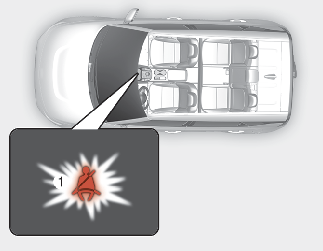
As a reminder to the driver, the driver's seat belt warning lights will appear for approximately 6 seconds each time you turn the ignition switch or ENGINE START/STOP button ON regardless of belt fastening. If the seatbelt is not fastened, the warning chime will sound for about 6 seconds.
If you start to drive without the seat belt fastened or you unfasten the seat belt when you drive under 20 km/h (12 mph) or stop, the corresponding warning light will appear.
If you start to drive without the seat belt fastened or you unfasten the seat belt when you drive 20 km/h (12 mph) and faster, the warning light will blink and warning chime will sound for approximately 100 seconds.
When the seat belt is unfastened during driving, the warning light will appear when the speed is under 20 km/h (12 mph).
When the speed is 20 km/h (12 mph) and faster, the warning light will blink and warning chime will sound for approximately 100 seconds.
Front passenger's seat belt warning (2) (if equipped)
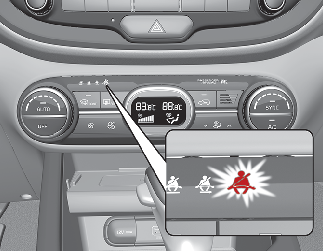
As a reminder to the front passenger, the front passenger's seat belt warning lights will appear for approximately 6 seconds each time you turn the ignition switch or ENGINE START/STOP button ON regardless of belt fastening.
If you start to drive without the seat belt fastened or you unfasten the seat belt when you drive under 20 km/h (12 mph) or stop, the corresponding warning light will appear.
If you start to drive without the seat belt fastened or you unfasten the seat belt when you drive 20 km/h (12 mph) and faster, the warning light will blink and warning chime will sound for approximately 100 seconds.
When the seat belt is unfastened during driving, the warning light will appear when the speed is under 20 km/h (12 mph). When the speed is 20 km/h (12 mph) and faster, the warning light will blink and warning chime will sound for approximately 100 seconds.

Riding in an improper position adversely affects the front passenger's seat belt warning system. It is important for the driver to instruct the passenger as to the proper seating instructions as contained in this manual.

-
You can find the front passenger's seat belt warning light on the center fascia panel.
-
Although the front passenger seat is not occupied, the seat belt warning light will appear for 6 seconds.
-
The front passenger's seat belt warning may operate when luggage is placed on the front passenger seat.
Rear passenger's seat belt warning (3,4,5) (if equipped)
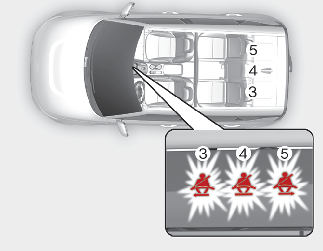
As a reminder to the rear passenger, the rear passenger's seat belt warning lights will appear for approximately 6 seconds each time you turn the ignition switch or ENGINE START/STOP button ON regardless of belt fastening.
If the seat belt is not fastened when the ignition switch or ENGINE START/STOP button is turned ON, the seat belt warning light will appear for approximately 70 seconds.
If you start to drive without the seat belt fastened or you unfasten the seat belt when you drive under 20 km/h (12 mph), the corresponding warning light will continue to appear for approximately 70 seconds.
If you continue to drive without the seat belt fastened or you unfasten the seat belt when you drive over 20 km/h (12 mph), the seat belt warning chime will sound for approximately 35 seconds and the corresponding warning light will blink.
If the rear door is opened or closed under 20 km/h (12 mph), warning light and warning sound does not work even if driving over 20 km/h (12 mph).
Lap/shoulder belt
Height adjustment
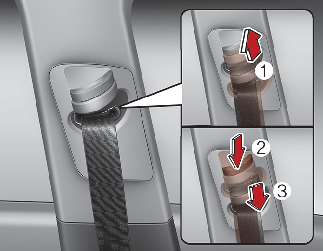
You can adjust the height of the shoulder belt anchor to one of 3 positions for maximum comfort and safety.
The height of the adjusting seat belt should not be too close to your neck. You will not be getting the most effective protection. The shoulder portion should be adjusted so that it lies across your chest and midway over your shoulder near the door and not your neck.
To adjust the height of the seat belt anchor, lower or raise the height adjuster into an appropriate position.
To raise the height adjuster, pull it up (1). To lower it, push it down (3) while pressing the height adjuster button (2).
Release the button to lock the anchor into position. Try sliding the height adjuster to make sure that it has locked into position.
Improperly positioned seat belts can cause serious injuries in an accident.

-
Verify the shoulder belt anchor is locked into position at the appropriate height. Never position the shoulder belt across your neck or face.
-
Failure to replace seat belts after an accident could leave you with damaged seat belts that will not provide protection in the event of another collision leading to personal injury or death. Replace your seat belts after being in an accident as soon as possible.
To fasten your seat belt:
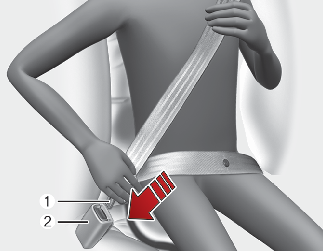
To fasten your seat belt, pull it out of the retractor and insert the metal tab (1) into the buckle (2). There will be an audible "click" when the tab locks into the buckle.
The seat belt automatically adjusts to the proper length only after the lap belt portion is adjusted manually so that it fits snugly around your hips. If you lean forward in a slow, easy motion, the belt will extend and let you move around. If there is a sudden stop or impact, however, the belt will lock into position. It will also lock if you try to lean forward too quickly

If you are not able to pull out the seat belt from the retractor, firmly pull the belt out and release it. Then you will be able to pull the belt out smoothly.
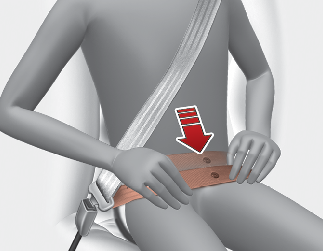

You should place the lap belt portion as low as possible and snugly across your hips, not on your waist. If the lap belt is located too high on your waist,it may increase the chance of injury in the event of a collision. Both arms should not be under or over the belt. Rather,one should be over and the other under, as shown in the illustration.
Never wear the seat belt under the arm near the door.
To release the seat belt:
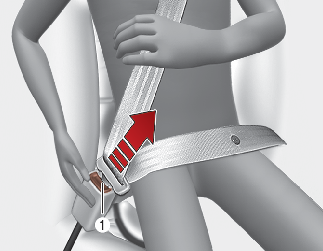
The seat belt is released by pressing the release button (1) in the locking buckle. When it is released, the belt should automatically draw back into the retractor.
If this does not happen, check the belt to be sure it is not twisted, then try again.
The seat belt should be locked into the buckle on each seat cushion to be properly fastened.
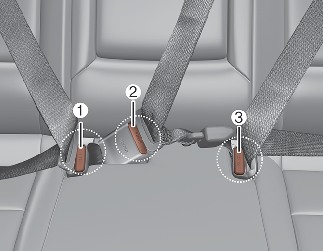
-
Rear right seat belt fastening buckle
-
Rear center seat belt fastening buckle
-
Rear left seat belt fastening buckle
When using the rear center seat belt, the buckle with the "CENTER" mark must be used.
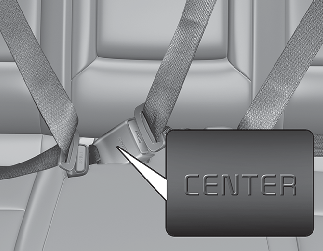

Do not force to lock the left or right seat belt into the center seat belt buckle.
Make sure to lock the rear center seat belt into the center seat belt buckle.
If not, the improperly fastened seat belt will not be able to provide protection.
3 Point rear center belt
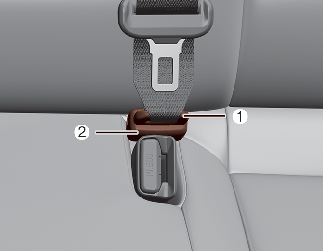

Rear center seat belt
Do not separate mini tongue (1) and mini buckle (2) even if there is not an occupant.
If it is separated, It may hit the rear seat occupants in a collision or sudden stops.
Pull the tongue plate and insert the tongue plate into the open end of the buckle until an audible "click" is heard, indicating the latch is locked. Make sure the belt is not twisted.
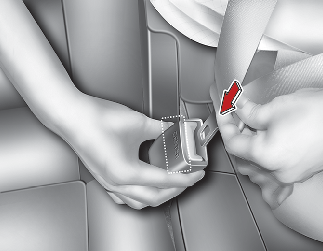

When using the rear center seat belt, the buckle with the "CENTER" mark must be used.
There will be an audible "click" when the tab locks in the buckle. The seat belt automatically adjusts to the proper length only after the lap belt is adjusted manually so that it fits snugly around your hips, if you lean forward in a slow, easy motion, the belt will extend and let you move around. If there is a sudden stop or impact, the belt will lock into position. It will also lock if you try to lean forward too quickly.

When using the rear seat center belt, you must lock all tongue plates and buckles. If any tongue plate or buckle is not locked, it will increase the chance of injury in the event of collision.